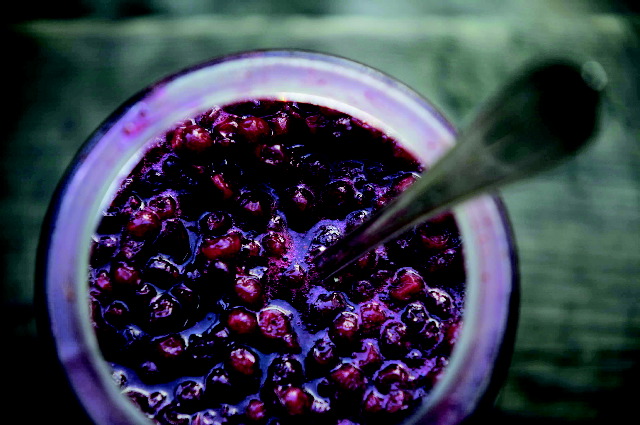Jam
Jam\, n. [Prob. fr. jam, v.; but cf. also Ar. jamad ice,
jelly, j[=a]mid congealed, jamd congelation, ice.] A preserve of
fruit boiled with sugar and water; as, raspberry jam; currant jam;
grape jam.
Webster's Revised Unabridged
Dictionary
 Ancient methods of conserving fruit included simply storing the fruit away from air and light, sun drying, and preserving fruit in honey or a reduction of grape syrup. These first conserves were valued for their medicinal properties in reducing fever, for stomach ailments, gum inflammation, as emollients, cough suppressants, and for other various therapuetic values.
Ancient methods of conserving fruit included simply storing the fruit away from air and light, sun drying, and preserving fruit in honey or a reduction of grape syrup. These first conserves were valued for their medicinal properties in reducing fever, for stomach ailments, gum inflammation, as emollients, cough suppressants, and for other various therapuetic values.
The earliest confectioners were apothecaries and basic jam and preserve recipes were valued, and sometimes elaborated upon to include herbs and spices to increase their medicinal value. Jam was taken by spoon, aged and fermented, reduced to tablets, and traded across continents. This practice of jam as electuary survives today in folk culture through generational recipes such as Rosehip Jam (for Vitamin C) and Raspberry Ginger Jam (for digestion).
One of the first recorded mentions of jam dates to the Crusades whose soldiers brought the process back from their journeys in the Middle East. These jams were made with cane sugar, which grew naturally in Middle Eastern Countries. It is thought that Sassanid Persia and the Abbasid Dynasty of the Arabs first introduced sugar into medicines and cooking.
The first jam recipes that called for sugar in Europe were written by 12th century physician Psuedo-Mesue of Italy, and included Apple, Plum, and Peach Jams.
In the United States, early New England settlers preserved fruits with honey, molasses, or maple sugar. Pectin from apple parings was used to thicken jellies and jams. Cane sugar was not widely available, and was a luxury item associated with the practice of slavery. Even with the Spanish sugar plantations in the West Indies from the 16th century, it was not until the introduction of beet sugar in the 19th century that sugared jams became more widely distributed in society.
 To learn more about Jam and Jelly, please go to the official International Jelly and Preserve Association website at www.jelly.org
To learn more about Jam and Jelly, please go to the official International Jelly and Preserve Association website at www.jelly.org

 Ancient methods of conserving fruit included simply storing the fruit away from air and light, sun drying, and preserving fruit in honey or a reduction of grape syrup. These first conserves were valued for their medicinal properties in reducing fever, for stomach ailments, gum inflammation, as emollients, cough suppressants, and for other various therapuetic values.
Ancient methods of conserving fruit included simply storing the fruit away from air and light, sun drying, and preserving fruit in honey or a reduction of grape syrup. These first conserves were valued for their medicinal properties in reducing fever, for stomach ailments, gum inflammation, as emollients, cough suppressants, and for other various therapuetic values.